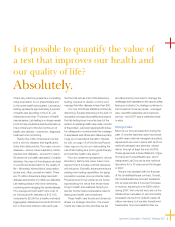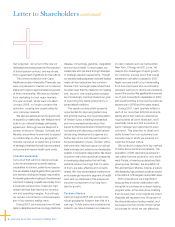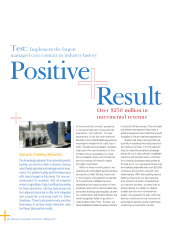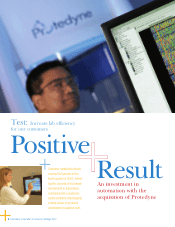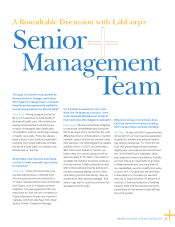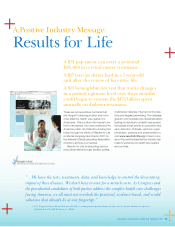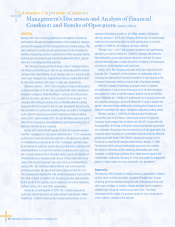LabCorp 2007 Annual Report Download - page 15
Download and view the complete annual report
Please find page 15 of the 2007 LabCorp annual report below. You can navigate through the pages in the report by either clicking on the pages listed below, or by using the keyword search tool below to find specific information within the annual report.
Laboratory Corporation of America® Holdings 2007 13
The past 12 months have marked an
intense period of change, particularly
with regard to managed care contracts.
Have these new agreements resulted in
new pricing pressures for the industry?
Dave King: Pricing pressure is a fact of
life in our business and, quite frankly, in
all areas of health care. All providers are
seeing reimbursement reductions as
a result of managed care health plan
consolidation and the continuing increase
in health care costs. Price has always
been a factor in any contract negotiation.
Certainly, the UnitedHealthcare contract
kicked off a price reset, but I believe one
already was on the way.
Specifi cally, how does the new Cigna
contract create a growth opportunity
for LabCorp?
Dave King: Under the old contract, our
representatives were prohibited from
informing physicians and patients in
17 major markets that we were contracted
with Cigna, due to a legacy contract
restriction. The new agreement lifts this
restriction so that we can compete for
Cigna business in these very important
markets, which include New York, New
Jersey, Florida, Texas and Georgia.
On a similar explanatory note, how
does the “leakage accounting” work
under the UnitedHealthcare contract?
How much does this obligation represent?
Brad Hayes: We are contractually obligated
to reimburse UnitedHealthcare during the
first three years of the contract for the cost
differential when a United patient, in certain
markets, uses a national lab provider other
than LabCorp. Our total obligation is capped
at $200 million. In 2007, we were billed
$38 million and, based on trends, we
believe that our overall exposure will be
approximately $115 million. The ability to
complete the buildout of service centers in
a timely manner, initiate personal contact
with United-related accounts and accom-
modate increased testing volume, while
maintaining service standards, have all
combined to help minimize leakage. This
was a huge test for LabCorp and one that
we passed convincingly.
What percentage of revenues does
LabCorp derive from esoteric testing,
and how are these revenues trending?
Bill Haas: At year-end 2007, approximately
34 percent of our revenues were generated
by genomic, esoteric and anatomic pathol-
ogy testing categories. For the first time
ever, this percentage actually declined
slightly year-over-year as we transitioned
the UnitedHealthcare business, which
was weighted toward core testing. Actually,
we view this as an opportunity to go back
to these accounts and convince them of
our capabilities, superior quality and ease
to work with. Our goal over the next three
to five years is to increase our esoteric
test mix to approximately 40 percent of
revenue. Continued adoption of existing
esoteric tests and the development and
acceptance of new esoteric tests will help
drive this growth.
Senior
A Roundtable Discussion with LabCorp’s
Management
Te a m


